Optical Characteristics of ZnCuInS/ZnS (Core/Shell) Nanocrystal Flexible Films Under X-Ray Excitation
Abstract
:1. Introduction
2. Materials and Methods
3. Results
4. Discussion
5. Conclusions
Author Contributions
Funding
Conflicts of Interest
References
- Kalyvas, N.; Liaparinos, P.; Michail, C.; David, S.; Fountos, G.; Wójtowicz, M.; Zych, E.; Kandarakis, I. Studying the luminescence efficiency of Lu2O3:Eu nanophosphor material for digital X-ray imaging applications. Appl. Phys. A 2012, 106, 131–136. [Google Scholar] [CrossRef]
- Seferis, I.; Michail, C.; Valais, I.; Zeler, J.; Liaparinos, P.; Fountos, G.; Kalyvas, N.; David, S.; Stromatia, F.; Zych, E.; et al. Light emission efficiency and imaging performance of Lu2O3:Eu nanophosphor under X-ray radiography conditions: Comparison with Gd2O2S:Eu. J. Lumin. 2014, 151, 229–234. [Google Scholar] [CrossRef]
- Lai, C.-F.; Wang, Y.-C. Colloidal Photonic Crystals Containing Silver Nanoparticles with Tunable Structural Colors. Crystals 2016, 6, 61. [Google Scholar] [CrossRef]
- He, Z.; Zhang, C.; Dong, Y.; Wu, S.-T. Emerging Perovskite Nanocrystals-Enhanced Solid-State Lighting and Liquid-Crystal Displays. Crystals 2019, 9, 59. [Google Scholar] [CrossRef]
- Zych, E.; Meijerink, A.; de Mello Doneg, C. Quantum efficiency of europium emission from nanocrystalline powders of Lu2O3:Eu. J. Phy. Condens. Matter. 2003, 15, 5145–5155. [Google Scholar] [CrossRef]
- Konstantatos, G.; Sargent, E.H. Colloidal quantum dot photodetectors. Infrared Phys. Technol. 2011, 54, 278–282. [Google Scholar] [CrossRef]
- Siffalovic, P.; Badanova, D.; Vojtko, A.; Jergel, M.; Hodas, M.; Pelletta, M.; Sabol, D.; Macha, M.; Majkova, E. Evaluation of low-cadmium ZnCdSeS alloyed quantum dots for remote phosphor solid-state lighting technology. Appl. Opt. 2015, 54, 7094. [Google Scholar] [CrossRef]
- Zeng, R.; Sun, Z.; Cao, S.; Shen, R.; Liu, Z.; Long, J.; Zheng, J.; Shen, Y.; Lin, X. A facile route to aqueous Ag:ZnCdS and Ag:ZnCdSeS quantum dots: Pure emission color tunable over entire visible spectrum. J. Alloys. Compd. 2015, 632, 1–9. [Google Scholar] [CrossRef]
- Zhang, C.; Du, L.; Liu, C.; Li, Y.; Yang, Z.; Cao, Y.-C. Photostable epoxy polymerized carbon quantum dots luminescent thin films and the performance study. Results Phy. 2016, 6, 767–771. [Google Scholar] [CrossRef] [Green Version]
- Guo, S.; Konopny, L.; Popovitz-Biro, R.; Cohen, H.; Sirota, M.; Lifshitz, E.; Lahav, M. Topotactic Release of CdS and Cd1-xMnxS from Solid Thioalkanoates with Ammonia to Yield Quantum Particles Arranged in Layers Within an Organic Composite. Adv. Mater. 2000, 12, 302–306. [Google Scholar] [CrossRef]
- Eychmüller, A. Structure and Photophysics of Semiconductor Nanocrystals. J. Phy. Chem. B 2000, 104, 6514–6528. [Google Scholar] [CrossRef]
- Valais, I.; Michail, C.; Fountzoula, C.; Tseles, D.; Yannakopoulos, P.; Nikolopoulos, D.; Bakas, A.; Fountos, G.; Saatsakis, G.; Sianoudis, I.; et al. On the response of alloyed ZnCdSeS quantum dot films. Results Phys. 2017, 7, 1734–1736. [Google Scholar] [CrossRef]
- Michail, C.; Karpetas, G.; Kalyvas, N.; Valais, I.; Kandarakis, I.; Agavanakis, K.; Panayiotakis, G.; Fountos, G. Information Capacity of Positron Emission Tomography Scanners. Crystals 2018, 8, 459. [Google Scholar] [CrossRef]
- Salomoni, M.; Pots, R.; Auffray, E.; Lecoq, P. Enhancing Light Extraction of Inorganic Scintillators Using Photonic Crystals. Crystals 2018, 8, 78. [Google Scholar] [CrossRef]
- Maddalena, F.; Tjahjana, L.; Xie, A.; Zeng, S.; Wang, H.; Coquet, P.; Drozdowski, W.; Dujardin, C.; Dang, C.; Birowosuto, M.D.; et al. Inorganic, Organic, and Perovskite Halides with Nanotechnology for High–Light Yield X- and γ-ray Scintillators. Crystals 2019, 9, 88. [Google Scholar] [CrossRef]
- Valais, I.; Michail, C.; Fountzoula, C.; Fountos, G.; Saatsakis, G.; Karabotsos, A.; Panayiotakis, G.S.; Kandarakis, I. Polymer Based Thin Film Screen Preparation Technique. J. Phys. Conf. Ser. 2017, 931, 012035. [Google Scholar] [CrossRef] [Green Version]
- Saatsakis, G.; Valais, I.; Michail, C.; Fountzoula, C.; Fountos, G.; Koukou, V.; Martini, N.; Kalyvas, N.; Bakas, A.; Sianoudis, I.; et al. Preliminary Study of ZnS:Mn2+ Quantum Dots Response Under UV and X-Ray Irradiation. J. Phys. Conf. Ser. 2017, 931, 012030. [Google Scholar] [CrossRef]
- Pang, L.; Shen, Y.; Tetz, K.; Fainman, Y. PMMA quantum dots composites fabricated via use of pre-polymerization. Opt. Express 2005, 13, 44. [Google Scholar] [CrossRef]
- Public Health England, Cadmium: Health Effects, Incident Management And Toxicology Information On Cadmium, For Responding To Chemical Incidents [Online]. Available online: https://www.gov.uk/government/publications/cadmium-properties-incident-management-and-toxicology (accessed on 3 July 2019).
- Dong, X.; Xu, J.; Shi, S.; Zhang, X.; Li, L.; Yin, S. Electroluminescence from ZnCuInS/ZnS quantum dots/poly(9-vinylcarbazole) multilayer films with different thicknesses of quantum dot layer. J. Phys. Chem. Solids 2017, 104, 133–138. [Google Scholar] [CrossRef]
- Jia, Y.; Wang, H.; Xiang, L.; Liu, X.; Wei, W.; Ma, N.; Sun, D. Tunable emission properties of core-shell ZnCuInS-ZnS quantum dots with enhanced fluorescence intensity. J. Mater. Sci. Technol. 2018, 34, 942–948. [Google Scholar] [CrossRef]
- Guo, W.; chen, N.; Tu, Y.; Dong, C.; Zhang, B.; Hu, C.; Chang, J. Synthesis of Zn-Cu-In-S/ZnS Core/Shell Quantum Dots with Inhibited Blue-Shift Photoluminescence and Applications for Tumor Targeted Bioimaging. Theranostics 2013, 3, 99–108. [Google Scholar] [CrossRef]
- Wang, X.; Liang, Z.; Xu, X.; Wang, N.; Fang, J.; Wang, J.; Xu, G. A high efficient photoluminescence Zn–Cu–In–S/ZnS quantum dots with long lifetime. J. Alloys Compd. 2015, 640, 134–140. [Google Scholar] [CrossRef]
- American Elements, ZnCuInS/ZnS Quantum Dots [Online]. Available online: https://www.americanelements.com/zncuins-zns-quantum-dots (accessed on 3 July 2019).
- Michail, C.M.; Fountos, G.P.; Liaparinos, P.F.; Kalyvas, N.E.; Valais, I.; Kandarakis, I.S.; Panayiotakis, G.S. Light emission efficiency and imaging performance of Gd2O2S:Eu powder scintillator under x-ray radiography conditions: Light emission efficiency and imaging performance of Gd2O2S:Eu. Med. Phys. 2010, 37, 3694–3703. [Google Scholar] [CrossRef]
- Magnan, P. Detection of visible photons in CCD and CMOS: A comparative view. Nucl. Instrume. Methods Phys. Res. A 2003, 504, 199–212. [Google Scholar] [CrossRef]
- Kalivas, N.; Valais, I.; Nikolopoulos, D.; Konstantinidis, A.; Gaitanis, A.; Cavouras, D.; Nomicos, C.D.; Panayiotakis, G.; Kandarakis, I. Light emission efficiency and imaging properties of YAP:Ce granular phosphor screens. Appl. Phys. A 2007, 89, 443–449. [Google Scholar] [CrossRef]
- Kandarakis, I.; Cavouras, D.; Nikolopoulos, D.; Anastasiou, A.; Dimitropoulos, N.; Kalivas, N.; Ventouras, E.; Kalatzis, I.; Nomicos, C.; Panayiotakis, G. Evaluation of ZnS:Cu phosphor as X-ray to light converter under mammographic conditions. Radiat. Meas. 2005, 39, 263–275. [Google Scholar] [CrossRef]
- Cavouras, D.; Kandarakis, I.; Nikolopoulos, D.; Kalatzis, I.; Kagadis, G.; Kalivas, N.; Episkopakis, A.; Linardatos, D.; Roussou, M.; Nirgianaki, E.; et al. Light emission efficiency and imaging performance of Y3Al5O12: Ce (YAG: Ce) powder screens under diagnostic radiology conditions. Appl. Phys. B 2005, 80, 923–933. [Google Scholar] [CrossRef]
- Seferis, I.E.; Zeler, J.; Michail, C.; Valais, I.; Fountos, G.; Kalyvas, N.; Bakas, A.; Kandarakis, I.; Zych, E. On the response of semitransparent nanoparticulated films of LuPO4:Eu in poly-energetic X-ray imaging applications. Appl. Phys. A 2016, 122. [Google Scholar] [CrossRef]
- Michail, C.; Kalyvas, N.; Bakas, A.; Ninos, K.; Sianoudis, I.; Fountos, G.; Kandarakis, I.; Panayiotakis, G.; Valais, I. Absolute Luminescence Efficiency of Europium-Doped Calcium Fluoride (CaF2:Eu) Single Crystals under X-ray Excitation. Crystals 2019, 9, 234. [Google Scholar] [CrossRef]
- Nikolopoulos, D.; Kalyvas, N.; Valais, I.; Argyriou, X.; Vlamakis, E.; Sevvos, T.; Kandarakis, I. A semi-empirical Monte Carlo based model of the Detector Optical Gain of Nuclear Imaging scintillators. J. Instrum. 2012, 7, P11021. [Google Scholar] [CrossRef]
- Kalyvas, N.; Valais, I.; David, S.; Michail, C.; Fountos, G.; Liaparinos, P.; Kandarakis, I. Studying the energy dependence of intrinsic conversion efficiency of single crystal scintillators under X-ray excitation. Opt. Spectr. 2014, 116, 743–747. [Google Scholar] [CrossRef]
- Kalyvas, N.; Valais, I.; Michail, C.; Fountos, G.; Kandarakis, I.; Cavouras, D. A theoretical study of CsI:Tl columnar scintillator image quality parameters by analytical modeling. Nucl. Instrume. Methods Phys. Res. 2015, 779, 18–24. [Google Scholar] [CrossRef]
- David, S.; Michail, C.; Seferis, I.; Valais, I.; Fountos, G.; Liaparinos, P.; Kandarakis, I.; Kalyvas, N. Evaluation of Gd2O2S:Pr granular phosphor properties for X-ray mammography imaging. J. Lumin. 2016, 169, 706–710. [Google Scholar] [CrossRef]
- Kalivas, N.; Costaridou, L.; Kandarakis, I.; Cavouras, D.; Nomicos, C.D.; Panayiotakis, G. Effect of intrinsic-gain fluctuations on quantum noise of phosphor materials used in medical X-ray imaging. Appl. Phys. A Mater. Sci. Process. 1999, 69, 337–341. [Google Scholar] [CrossRef]
- Zhang, F.; He, X.; Ma, P.; Sun, Y.; Wang, X.; Song, D. Rapid aqueous synthesis of CuInS/ZnS quantum dots as sensor probe for alkaline phosphatase detection and targeted imaging in cancer cells. Talanta 2018, 189, 411–417. [Google Scholar] [CrossRef]
- Shakur, H.R. A detailed study of physical properties of ZnS quantum dots synthesized by reverse micelle method. Physica. E Low Dimen Syst. Nanostruct. 2011, 44, 641–646. [Google Scholar] [CrossRef]
- Mathew, S.; Bhardwaj, B.S.; Saran, A.D.; Radhakrishnan, P.; Nampoori, V.P.N.; Vallabhan, C.P.G.; Bellare, J.R. Effect of ZnS shell on optical properties of CdSe–ZnS core–shell quantum dots. Opt. Mater. 2015, 39, 46–51. [Google Scholar] [CrossRef]
- Fiaczyk, K.; Zych, E. On peculiarities of Eu3+ and Eu2+ luminescence in Sr2GeO4 host. RSC Adv. 2016, 6, 91836–91845. [Google Scholar] [CrossRef]
- Zeler, J.; Cybińska, J.; Zych, E. A new photoluminescent feature in LuPO4:Eu thermoluminescent sintered materials. RSC Adv. 2016, 6, 57920–57928. [Google Scholar] [CrossRef]
- Jacobsohn, L.G.; Bennett, B.L.; Muenchausen, R.E.; Smith, J.F.; Wayne Cooke, D. Luminescent properties of nanophosphors. Radiat. Meas. 2007, 42, 675–678. [Google Scholar] [CrossRef]
- Refractiveindex.info. Available online: https://refractiveindex.info (accessed on 3 July 2019).
- Nowotny, R. XMuDat: Photon attenuation data on PC. International Atomic Energy Agency, Nuclear Data Section. Available online: https://www-nds.iaea.org/publications/iaea-nds/iaea-nds-0195.htm (accessed on 3 July 2019).
- Plasmachem. Available online: www.plasmachem.com/shop/en/278-530-15-nm (accessed on 3 July 2019).
- Saatsakis, G.; Michail, C.; Fountzoula, C.; Kalyvas, N.; Bakas, A.; Ninos, K.; Fountos, G.; Sianoudis, I.; Kandarakis, I.; Panayiotakis, G.S.; et al. Fabrication and Luminescent Properties of Zn–Cu–In–S/ZnS Quantum Dot Films under UV Excitation. Appl. Sci. 2019, 9, 2367. [Google Scholar] [CrossRef]
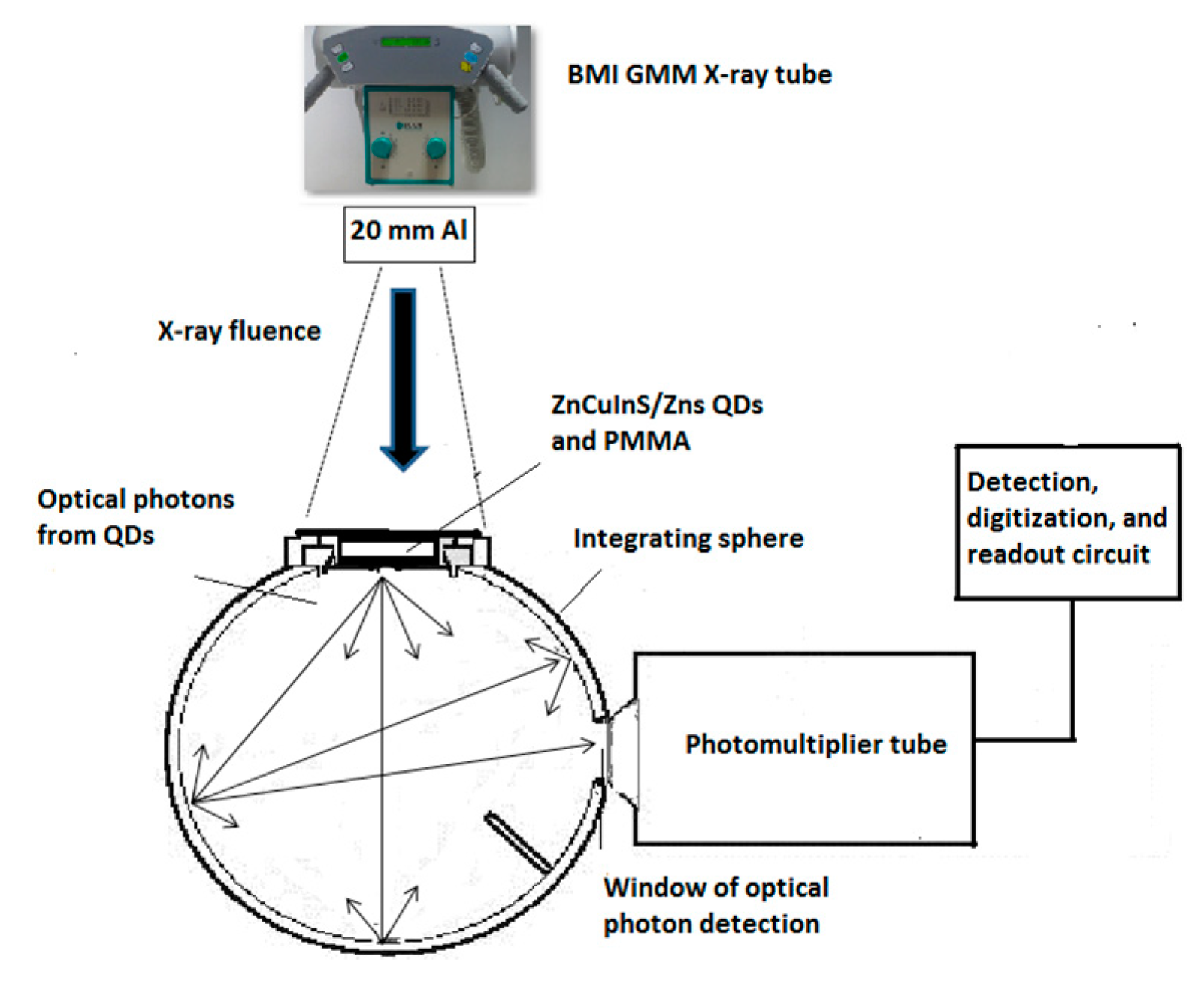
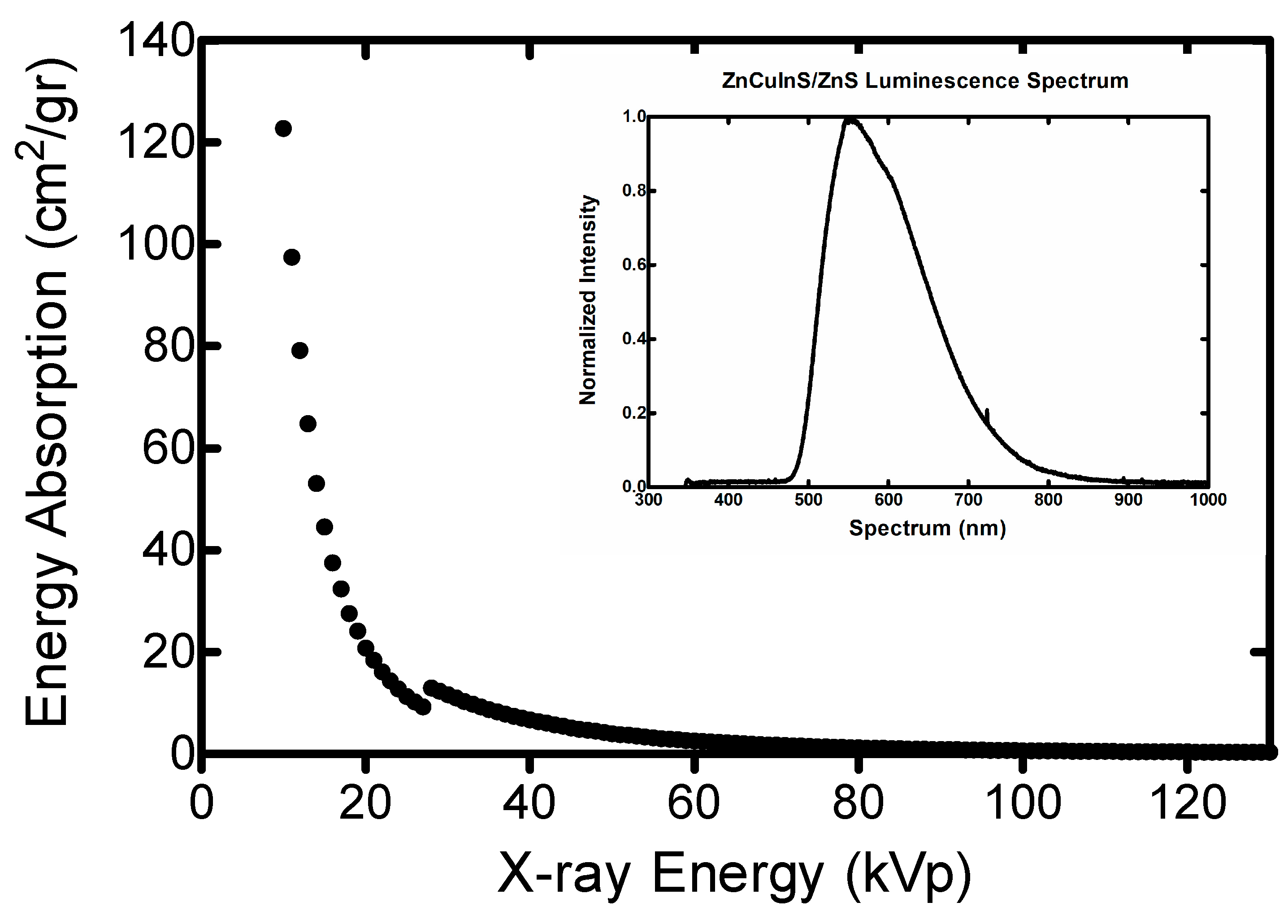
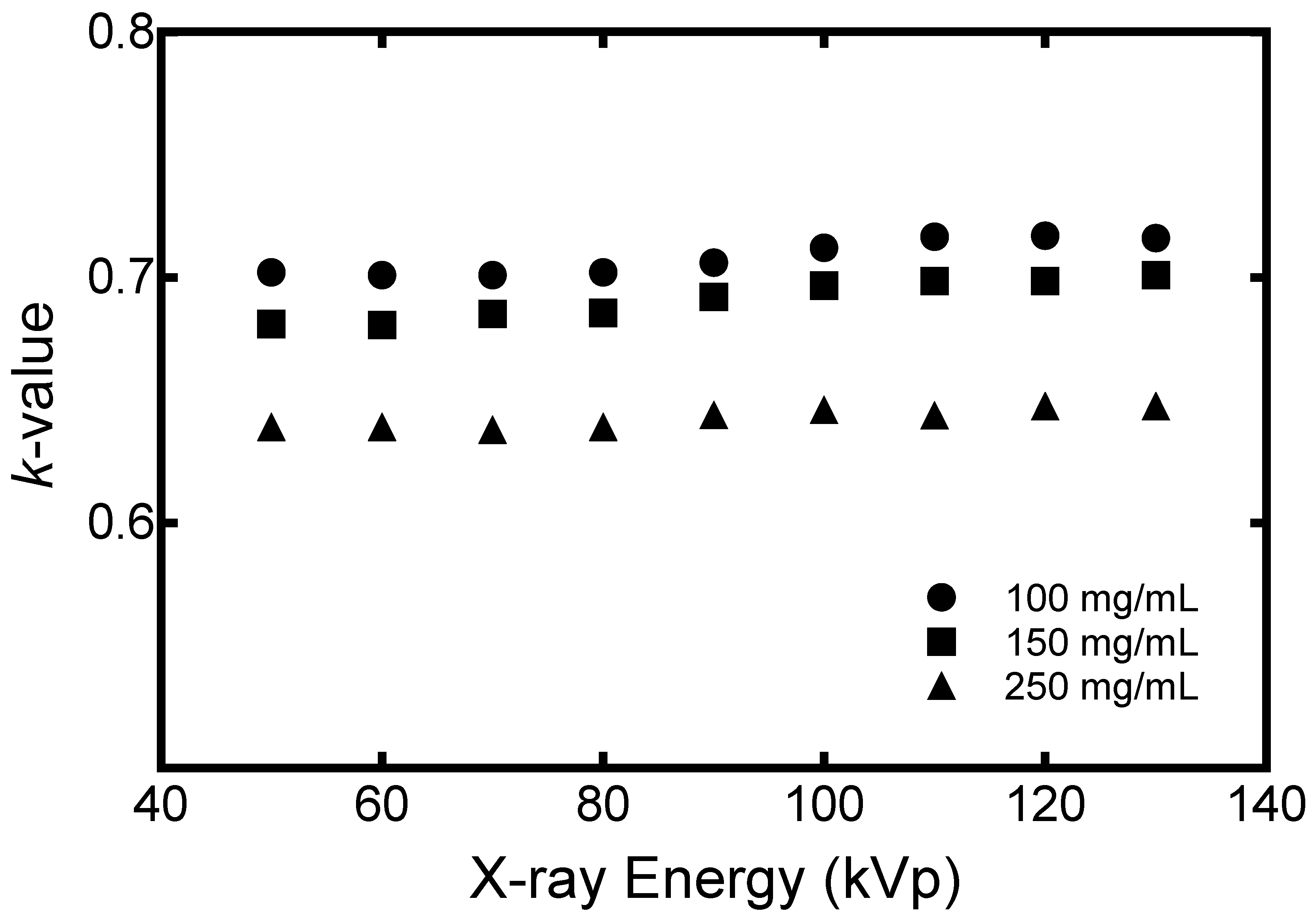
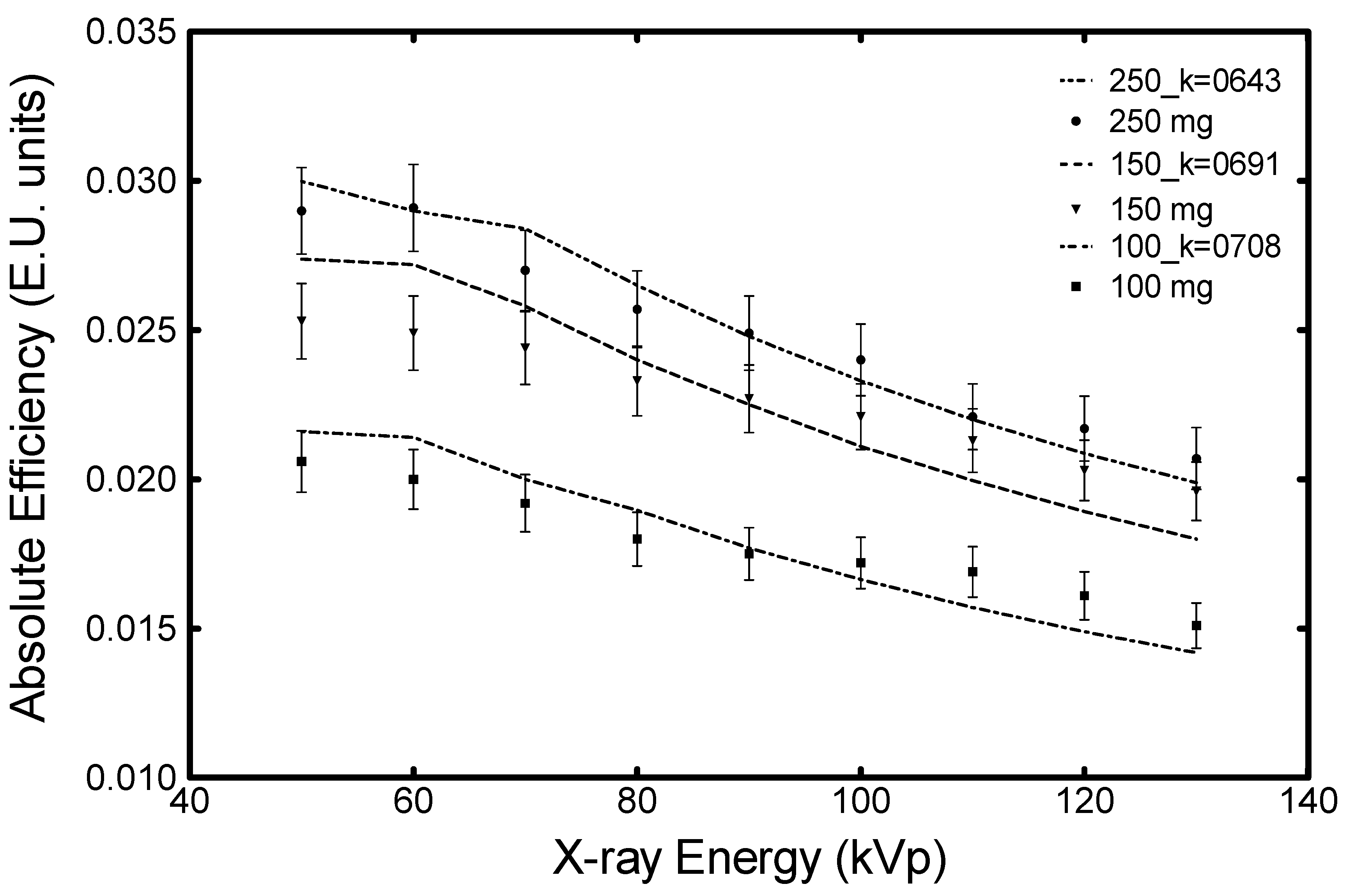
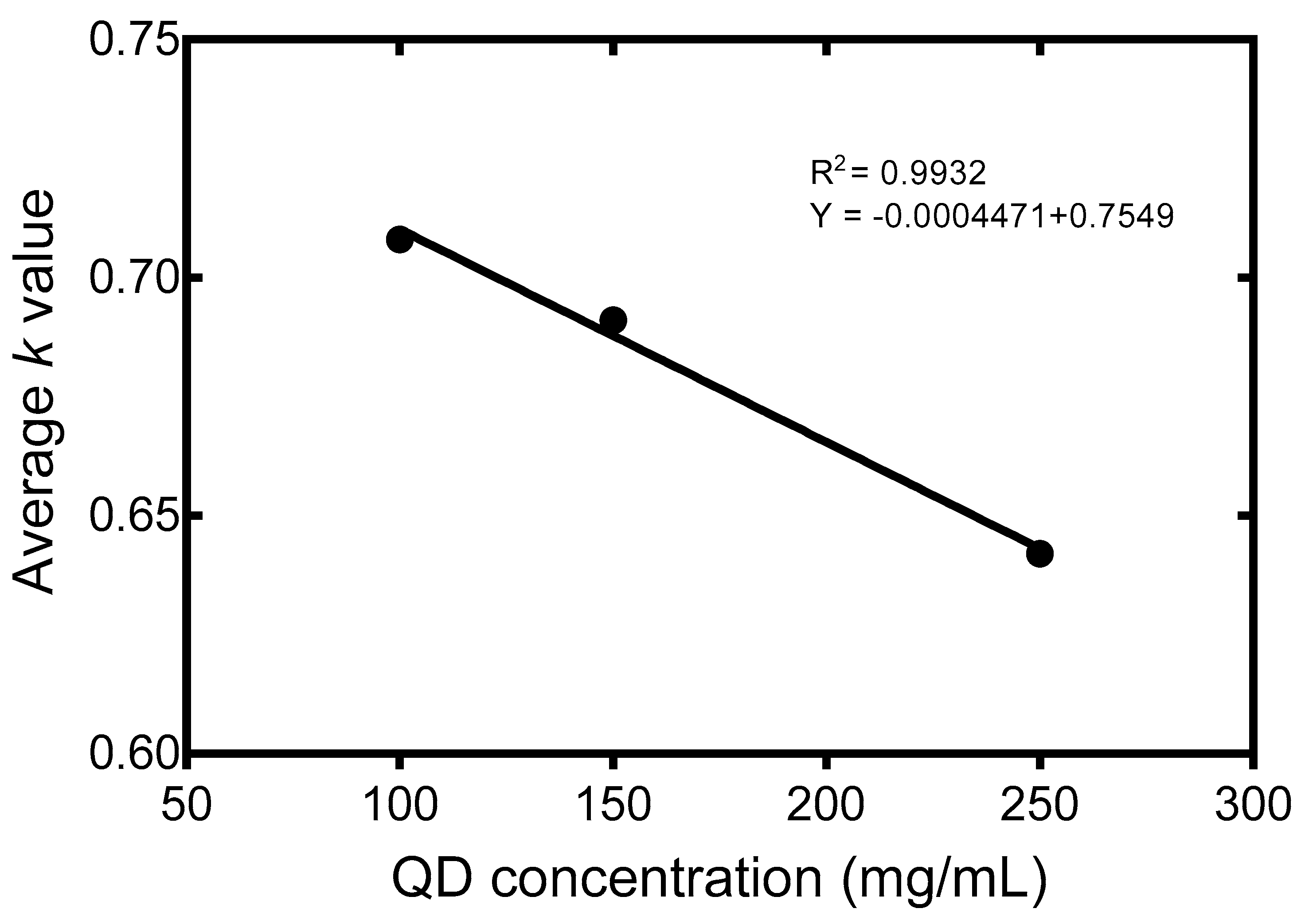
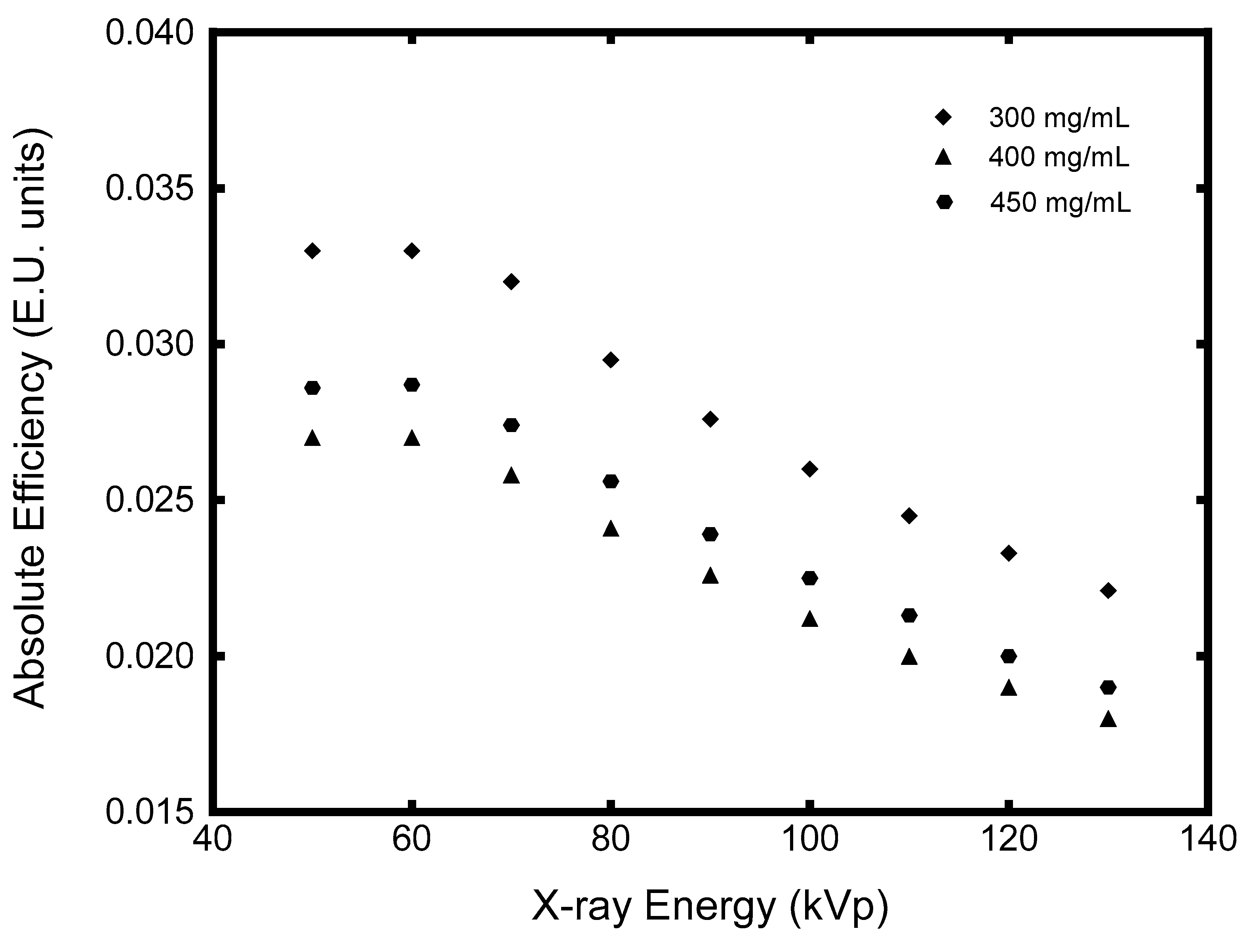
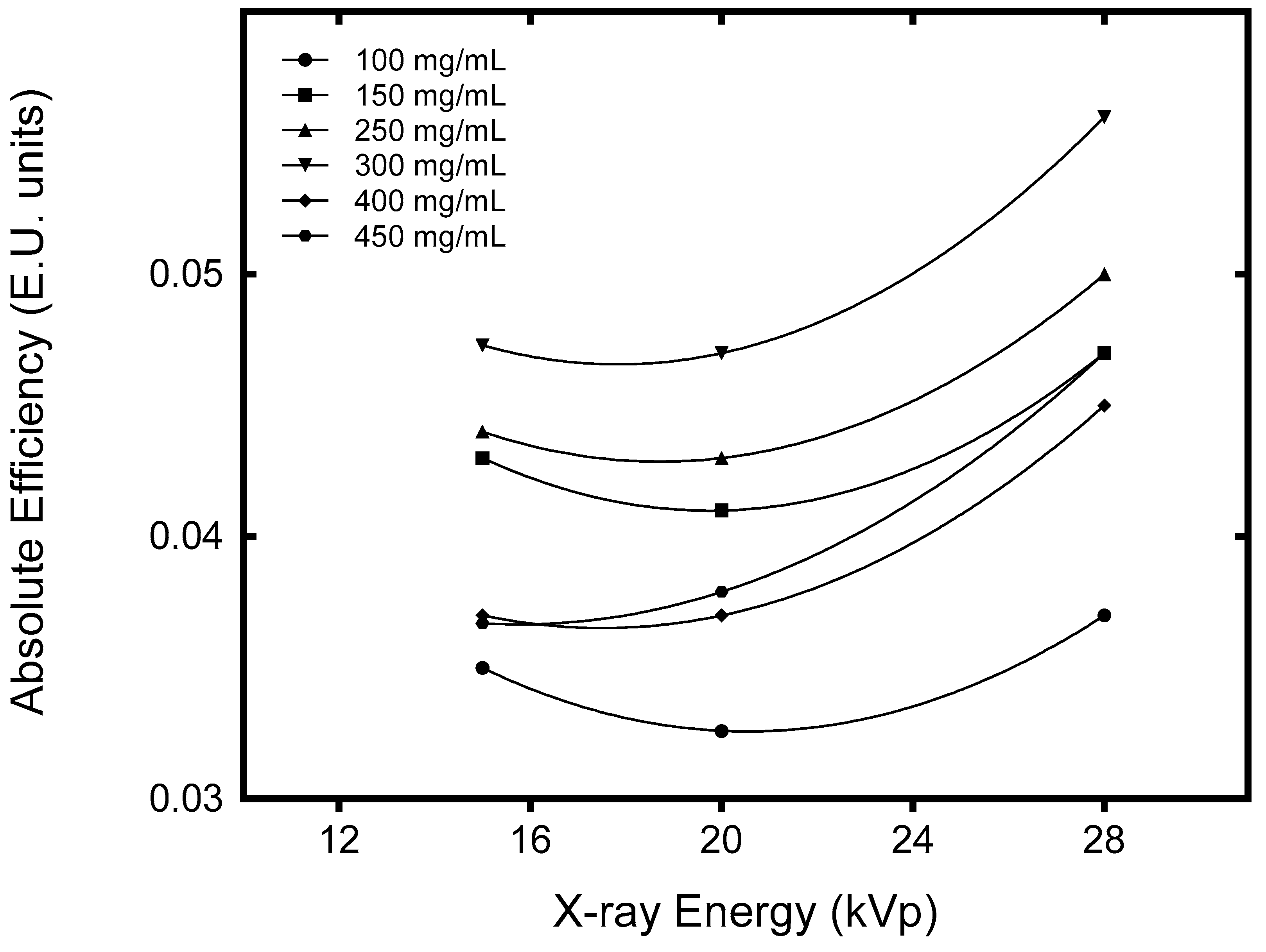
© 2019 by the authors. Licensee MDPI, Basel, Switzerland. This article is an open access article distributed under the terms and conditions of the Creative Commons Attribution (CC BY) license (http://creativecommons.org/licenses/by/4.0/).
Share and Cite
Saatsakis, G.; Kalyvas, N.; Michail, C.; Ninos, K.; Bakas, A.; Fountzoula, C.; Sianoudis, I.; Karpetas, G.E.; Fountos, G.; Kandarakis, I.; et al. Optical Characteristics of ZnCuInS/ZnS (Core/Shell) Nanocrystal Flexible Films Under X-Ray Excitation. Crystals 2019, 9, 343. https://doi.org/10.3390/cryst9070343
Saatsakis G, Kalyvas N, Michail C, Ninos K, Bakas A, Fountzoula C, Sianoudis I, Karpetas GE, Fountos G, Kandarakis I, et al. Optical Characteristics of ZnCuInS/ZnS (Core/Shell) Nanocrystal Flexible Films Under X-Ray Excitation. Crystals. 2019; 9(7):343. https://doi.org/10.3390/cryst9070343
Chicago/Turabian StyleSaatsakis, George, Nektarios Kalyvas, Christos Michail, Konstantinos Ninos, Athanasios Bakas, Christina Fountzoula, Ioannis Sianoudis, George E. Karpetas, George Fountos, Ioannis Kandarakis, and et al. 2019. "Optical Characteristics of ZnCuInS/ZnS (Core/Shell) Nanocrystal Flexible Films Under X-Ray Excitation" Crystals 9, no. 7: 343. https://doi.org/10.3390/cryst9070343









